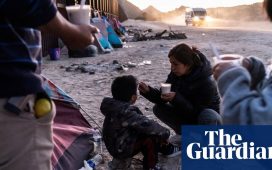Groups of men, women and children stepped off small boats and on to Mexican soil without showing their documents to anyone.
Drivers quickly bundled them into taxis which sped past an immigration office to a nearby crossroad, where the travelers climbed into a vans for the next leg of their journey toward the US border.
Mexico has announced it is imposing new travel restrictions on its southern border, because of the coronavirus – its first such restrictions since the pandemic began. It has also deployed police, national guard members and immigration officers to its southern states to slow the flow of migrants from Central America.
This week the White House announced that Mexico, Honduras and Guatemala would deploy troops “to make crossing the borders more difficult” as the Biden administration enlists its southern neighbours in its attempts to slow migration.
But on a recent morning it looked like business as usual on this remote stretch of the Mexico-Guatemala border, which follows the mighty Usumacinta River. Packs of haggard people trod along a narrow highway through the Lacandón jungle, toting backpacks and water bottles and occasionally perching toddlers on their shoulders.

Police checkpoints dot the 150km stretch of Highway 307 from Frontera Corozal to Palenque – the site of impressive Mayan ruins. But migrants said they simply paid to pass through – or were robbed by the officers they met.
“They’ve taken our money and now we’re dead broke,” said Christian, 27, who was traveling with a group of Honduran construction workers. “And now we have to deal with the military. We need to figure out how we get north. We are always fighting and figuring out a way to get there.”
Shortly after taking office in 2018, President Andrés Manuel López Obrador declared that Mexico’s migration and customs forces were “rotten to the core” and pledged a clean-up.
But human rights activists say soldiers, police officers and immigration officials are still guilty of crimes against migrants, ranging from robbery to extortion and kidnap for ransom.
“It’s a cartel,” said Father Gabriel Romero, director of La 72, a shelter for migrants near the Guatemala border. “They’re acting in cahoots with [smugglers] … with taxi and bus drivers. It’s a network taking advantage of migrants.”
Mexico has once again become a stopgap in US efforts to slow migration. And migrants have become a bargaining chip in the bilateral relationship.
Analysts say Mexico’s deployment of security forces to the southern border is yet another example of the US government outsourcing immigration enforcement to its neighbour.
“We’ve turned into a very strong and very heavy control apparatus, largely due to pressure from the US government,” said Tonatiuh Guillén López, a Mexican academic and former immigration commissioner.
The number of migrants arriving at the US border dropped under previous enforcement efforts, including one that followed a high-profile increase of migrant children reaching the US border in 2014, and the deployment of the National Guard after Donald Trump threatened to impose crippling sanctions if migration wasn’t stopped.
But such crackdowns have never completely stopped the flow of people, instead forcing migrants to take riskier routes through remote regions and exposing them to a heightened risk of robbery, rape, abduction and death.
Guillén, who resigned as immigration commissioner in June 2019 after Mexico buckled under Trump’s threats, expressed doubts that the country’s enforcement efforts would work as effectively this time around. “The flow of migrants will continue moving, mostly because they’re in small groups … and a significant part of it is controlled by human traffickers,” he said.
Human traffickers, he said, “have infrastructure, money and complicit relationships [with the authorities].” Additionally, “governments in Mexico, the United States and Central America have never really put much of an effort into controlling these trafficking organisations”.

After a call last week with US Vice-President Kamala Harris, López Obrador said: “We are willing to join forces in the fight against human trafficking and to protect human rights, especially of children.”
The two leaders also said they had agreed to work toward Central American development and “agreed on the urgency of carrying out emergency humanitarian aid programs”.
But whatever measures are agreed by the US and Mexican governments, they are unlikely to outweigh the many factors pushing Central Americans to feel their homes.
Migrants on the road through southern Mexico described escaping situations of abject poverty, hunger and violence. They described crops destroyed by drought and entire neighbourhoods devastated by hurricanes. They also spoke bitterly of politicians who oversee rampant corruption.
“Hurricane Eta swept away everything and left us in the street with our children,” said Leticia, 34, standing along the highway with her husband, Hector, and their three children aged 11, 12 and 14. “That’s why we decided to leave and search for a future.”
Johan Martínez, 34, said he had fled extortion payments in Honduras, despite lacking much of an income from his work as a welder. He pulled up his white singlet to show scars on his belly from being shot, and pointed to his front teeth. “Fake,” he said, explaining he had been hit with a pipe by angry gangsters seeking payment.
Like many of the migrants heading north, he seemed buoyed by the arrival of Biden, whose taking office he called “the opportunity of a lifetime”.

But getting out of Frontera Corozal was no easy task. Martínez and six fellow travellers paid taxi drivers 50 pesos for the privilege of walking through the town of 5,000 people – this after already paying to pass through migration checkpoints the length of Guatemala, he said. “It’s money, money, money,” he said.
The extent of human trafficking is easy to spot in Frontera Corozal, a scruffy tourist outpost populated by indigenous Chol families.
One local business owner, who preferred anonymity for security reasons, estimated that trafficking in migrants underpins 90% of the town’s economy.
He pointed to the crossroads, which was chockablock with migrants getting out of cabs and climbing into vans.
The vans paid 3,000 pesos to pass through various checkpoints, the business owner said. And when there’s a convoy of vans, “the checkpoints are only staffed so they can charge them,” he said.
The business owner sees migrants walking through the jungle around the perimeter of his property to avoid checkpoints. He provides them with food and water at a restaurant he operates and permits them to sleep in an abandoned vehicle.
But he serves smugglers, too. He broke from an interview to sell cans of beer to a pair of smugglers arriving in a new model car – part of a fleet of vehicles the smugglers used to discreetly move migrants, he said.
Migrants too poor to pay the smugglers end up walking – though they end up paying officials – who migrants say rifle through their backpacks and relieve them of their meagre belongings.
“The first thing they steal are cellular phones,” said Leticía, the Honduran migrant walking the highway with her family. She and her family had already been walking for two days in the sweltering heat and they were running out money.
“We made it here without eating. We’re drinking out of puddles.”
The sun was starting to set, and they still had 25km to go to reach the next migrant shelter. They turned north and started walking.







